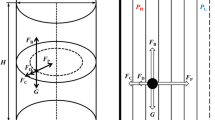Abstract
Particle-bubble collection characteristics from microbubble behavior in column flotation have been studied theoretically and experimentally. A flotation model taking into account particle collection has been developed by particle-bubble collision followed by the particle sliding over the bubble during which attachment may occur. Bubble size and bubble swarm velocity were measured as a function of frother dosage and superficial gas velocity to estimate the collision and collection efficiency. Separation tests were carried out to compare with theoretical particle recovery. Fly ash particles in the size range of <38, 38-75, 75-125, >125 mm were used as separation test particles. Theoretical collision and collection efficiencies were estimated by experimental data on the bubble behavior such as bubble size, gas holdup and bubble swarm velocity. Collection efficiency improved with an increase of the bubble size and particle size but decreased in the particle size up to 52 mm. Also, flotation rate constants were estimated to predict the optimum separation condition. From the theoretical results on the flotation rate constant, optimum separation condition was estimated as bubble size of 0.3-0.4 mm and superficial gas velocity of 1.5-2.0 cm/s. A decrease of bubble size improved the collection efficiency but did not improve particle recovery.
Similar content being viewed by others
References
Bando, Y., Kuze, T., Sugimoto, T., Yasuda, K. and Nakamura, M., “Development of Bubble Column for Foam Separation,”Korean J. Chem. Eng.,17, 5 (2000).
Bergh, L.G. and Yianatos, J. B., “Control Alternatives for Flotation Columns,”Minerals Engineering,6, 631 (1993).
Clift, R., Grace, J. R. and Weber, M. E., “Bubbles, Drops and Particles,” Academic Press, N.Y. (1978).
Dobby, G. S. and Finch, J.A., “A Model of Particle Sliding Time for Flotation Size Bubbles,”Journal of Colloid and Interface Science,109, 493 (1986).
Dobby, G. S. and Finch, J.A., “Particle Collection in Columns-Gas Rate and Bubble Size Effects,”Canadian Metallurgical Quarterly,25, 9 (1986).
Finch, J.A. and Dobby, G. S., “Column Flotation,” Pergamon Press, Oxford, England (1990).
Hur, J. M., Chang, D. and Chung, T.H., “Characteristics of Critical Solid-Liquid Separation and Its Effect on the Performance of an Anaerobic Sequencing Batch Reactor Treating Municipal Sludge,”Korean J. Chem. Eng.,15, 596 (1998)
Jiang, Z.W. and Holtham, P.N., “Theoretical Model of Collision between Particles and Bubbles in Flotation,”Trans. Instn. Min. Metall.,95, C187 (1986).
Kil, J.H., Choi, J.W., Noh, K. S. and Ha, B.H., “Study on Removal of Unburned Carbon From Fly Ash by Column Flotation,”HWAHAK KONGHAK,37, 719 (1999).
LeClair, B. P., Ph.D. Thesis, McMaster University, Hamilton, Ontario (1970).
Lee, D.H., Epstein, N. and Grace, J.R., “Hydrodynamic Transition from Fixed to Fully Fluidized Beds for Three-Phase Inverse Fluidization,”Korean J. Chem. Eng.,17, 684 (2000).
Lee, J. E., “Separation Characteristics from Fly Ash through the Analysis of Bubble Behavior in the Liquid/Gas Flow Field,” Ph.D. Thesis, Pusan National University, Pusan, Korea (1999).
Nam, S.H., Cho, Y. J., Kang, Y. and Kim, S. D., “Bubble Characteristics in Three-Phase Circulating Fluidized Beds,”HWAHAK KONGHAK,38, 859 (2000).
Patel, S. A., Daly, J.G. and Bukur, D. B., “Bubble Size Distribution in Fischer-Tropsch-Derived Waxes in a Bubble Column,”AIChE Journal,36, 93 (1990).
Reay, D. and Ratcliff, G. A., “Removal of Fine Particles from Water by Dispersed Air Flotation: Effects of Bubble Size and Particle Size on Collection Efficiency,”Canadian Journal of Chemical Engineering,51, 178 (1973).
Sutherland, K. L., “Kinetics of the Flotation Process,”Journal of Physics and Colloid Science,52, 394 (1948).
Tuteja, R.K., Spottiswood, D. J. and Misra, V.N., “Column Parameters: Their Effect on Entrainment in Froth,”Minerals Engineering,3, 1359 (1995).
Uribe-Salas, A., Gomez, C.O. and Finch, J.A., “A Conductivity Technique for Gas and Solids Holdup Determination in Three-Phase Reactors,”Chemical Engineering Science,49, 1 (1994).
Weber, M. E. and Paddock, D., “Interceptional and Gravitational Collision Efficiencies for Single Collectors at Intermediate Reynolds Numbers,”Journal of Colloid and Interface Science,94, 328 (1983).
Woo, S.W., Ph.D. Thesis, McMaster University, Hamilton, Ontario (1971).
Yamashita, F., “Effect of Geometrical Parameters of Draft Tubes and Clear Liquid Height on Gas Holdup in a Bubble Column for Gas Dispersion into Tubes,”Korean J.Chem. Eng.,16, 6 (1999).
Yianatos, J. B., Finch, J.A., Dobby, G. S. and Xu, M., “Bubble Size Estimation,”Journal of Colloid and Interface Science,126, 37 (1988).
Yoon, R.H., “Microbubble Flotation,”Minerals Engineering,6, 619 (1993).
Youn, J. M., Cho, Y. J., Kang, Y. and Kim, S.D., “Gas Holdup and Bubble Characteristics in Tapered Bubble Columns,”HWAHAK KONGHAK,38, 864 (2000).
Zhou, Z.A., Egiebor, N.O. and Plitt, L. R., “Frother Effects on Bubble Motion in a Swarm,”Canadian Metallurgical Quarterly,32, 89 (1993).
Author information
Authors and Affiliations
Corresponding author
Rights and permissions
About this article
Cite this article
Lee, JE., Lee, JK. Effect of microbubbles and particle size on the particle collection in the column flotation. Korean J. Chem. Eng. 19, 703–710 (2002). https://doi.org/10.1007/BF02699321
Received:
Accepted:
Issue Date:
DOI: https://doi.org/10.1007/BF02699321




